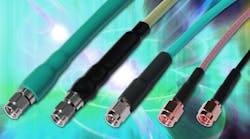This file type includes high resolution graphics and schematics when applicable.
The PE-P300LL series of low-loss coaxial cables has been developed for test applications from DC to 18 GHz. Available with a variety of different terminations, including stainless-steel Type-N, TNC, and SMA connectors, these phase-stable cable assemblies use a specially designed double-shielded, 0.3-in.-diameter coaxial cable with improved velocity of propagation through 18 GHz. The shielding effectiveness (SE) is better than 95 dB while the maximum VSWR is less than 1.35:1. A heavy duty boot and FEP jacket improve strain relief and allow for a minimum bend radius of 1.5 in. The cable assemblies are available in standard lengths from 12 to 60 in. and standard metric lengths of 50, 100, 150, and 200 cm.
Pasternack Enterprises, Inc., 17802 Fitch, Irvine, CA 92614; (949) 261-1920.
This file type includes high resolution graphics and schematics when applicable.

